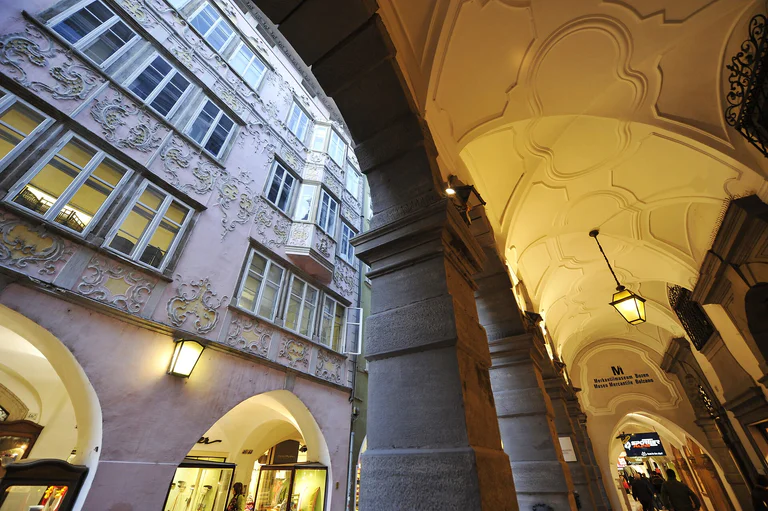Suldenbach
Der Suldenbach der im Prader Ortsteil Schmelz das enge Gebirgstal verlässt und später in die Etsch mündet, setzt sich aus dem Trafoi- und Suldnerbach samt deren Nebengewässer zusammen und nennt sich nach dem größeren der beiden, Suldenbach. Dieser Wildbach, im wahrsten Sinne des Wortes, hat die Geschicke des Dorfes Prad und seiner Bewohner stets maßgeblich geprägt. Der Suldenbach, noch von unseren Vätern als der Teufel selbst genannt, war bis zu seiner endgültigen Verbauung im 19. und vor allem 20. Jahrhundert unberechenbar. In seiner Urgewalt, ständig laufwechselnd, hatte der verheerende Wildbach, als Vollstrecker seiner Wut, den Bauern in Prad-Agums wiederholt auf Jahre die Hoffnung und den Böden die Fruchtbarkeit geraubt, indem er eine Unmenge von Steinen, Geröll und Sand zurückließ. Der Grundherr bzw. die Gerichtsbarkeit gewährte in solchen Fällen zwar einen Steuernachlass, aber weder den Ernte-Verlust noch die Furcht vor neuen Schicksalsschlägen des Vinschgau weit größten Wildbaches konnten sie nicht ersetzen. Ungeachtet der Willkür dieser Naturgewalten, gab es mitunter auch solche von Menschhand selbst ausgelöste Katastrophen. Darunter fallen jene,
die durch das Holztriften aus den Wäldern des Trafoi- und Suldentals auf dem Suldenbach verursacht wurden. So berichtet uns eine “Kundschaftsurkunde“ vom 17. September 1517, dass zu „Unzeiten“ (unbeaufsichtigt) der Holzrechen auf „Beide Wasser“ (Gomagoi) brach. Dieser hatte die Aufgabe das „angewasserte Holz“ (ins Wasser betriebene Holzstämme) aufzuhalten. An die 2000 Baumstämme wurden auf einen Schlag fortgeschwemmt und erreichten schließlich Prad. Unter dem Dorf bei der „Tschengler prugkhen“ machte das Triftholz einen „Knopf“, der Bach wurde aufgestaut, der Runst eingesandet bis zu den hintersten Kalköfen in der „Schmelz“. Wasser und Holz traten über die Ufer, drangen in Haus und Feld und zerstörten alles was sich ihnen in den Weg stellte. Das Holzflößen, von Prad bewilligt vom Heilig-Kreuz-Tag (14. 9) bis St. Jörgen-Tag (24.4.), verursachte stets eine Lockerung des Bergfußes sowie des Bachbettes selbst und war damit neben den Holz-Kahlschlägen Mitauslöser so manchen Unheils. Während die Lichtensteiner von Tschenglsberg als Grundherren für je 1000 Prügel, die auf dem Bache getriftet wurden, ein Pfund Pfeffer Zinsabgabe einforderten, blieb die ohnehin notorisch arme Bevölkerung bei Instandsetzung und Wiederaufbau von Flur und Haus zumeist auf sich gestellt.
Einer effizienten Bachverbauung standen hingegen nicht nur die Gemeinden von Mals, Tartsch und Glurns als Waldbesitzer im Trafoi- und Suldental, abgeneigt gegenüber, sondern natürlich auch die Kalkofen-Betreiber von Prad. Musste ihr Schlägerholz doch auf dem Wasserweg nach Prad transportiert werden. So blieb es der Bevölkerung von Prad-Agums überlassen, den Wassern des Suldenbaches, zumindest in Dorf-Nähe Einhalt zu gebieten. Allein die konstruktiven Maßnahmen reichten zumeist nur vorübergehend aus, einem anschwellenden Bach hielten die primitiven Archen nicht Stand. Eine wirkungsvolle Verbauung konnte schließlich erst durch Errichtung von gemauerten Klausen und Uferschutzmauern unter Leitung des Tiroler Bauamtes zu Beginn des 20. Jahrhunderts erzielt werden. Letzte Baumaßnahmen am 1600 m lang regulierten Bachlauf fanden mit einem Kostenaufwand von 1,86 Mrd. Lire in den Jahren von 1986 bis inklusive 1990 statt.































































































